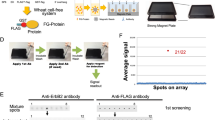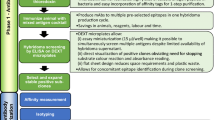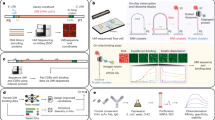Abstract
Although approximately 10,000 antibodies are available from commercial sources, antibody reagents are still unavailable for most proteins1. Furthermore, new applications such as antibody arrays2,3,4,5 and monoclonal antibody therapeutics6,7 have increased the demand for more specific antibodies to reduce cross-reactivity and side effects. An array containing every protein for the relevant organism represents the ideal format for an assay to test antibody specificity, because it allows the simultaneous screening of thousands of proteins for possible cross-reactivity. As an initial test of this approach, we screened 11 polyclonal and monoclonal antibodies to ∼5,000 different yeast proteins deposited on a glass slide and found that, in addition to recognizing their cognate proteins, the antibodies cross-reacted with other yeast proteins to varying degrees. Some of the interactions of the antibodies with noncognate proteins could be deduced by alignment of the primary amino acid sequences of the antigens and cross-reactive proteins; however, these interactions could not be predicted a priori. Our findings show that proteome array technology has potential to improve antibody design and selection for applications in both medicine and research.
This is a preview of subscription content, access via your institution
Access options
Subscribe to this journal
Receive 12 print issues and online access
$209.00 per year
only $17.42 per issue
Buy this article
- Purchase on Springer Link
- Instant access to full article PDF
Prices may be subject to local taxes which are calculated during checkout



Similar content being viewed by others
References
Kusnezow, W. & Hoheisel, J.D. Antibody microarrays: promises and problems. Biotechniques (Suppl.), 14–23 (2002).
Schweitzer, B. et al. Multiplexed protein profiling on microarrays by rolling-circle amplification. Nat. Biotechnol. 20, 359–365 (2002).
Haab, B.B., Dunham, M.J. & Brown, P.O. Protein microarrays for highly parallel detection and quantitation of specific proteins and antibodies in complex solutions. Genome Biol. 2, research0004.1–0004.13 (2001).
Knezevic, V. et al. Proteomic profiling of the cancer microenvironment by antibody arrays. Proteomics 1, 1271–1278 (2001).
Moody, M.D., Van Arsdell, S.W., Murphy, K.P., Orencole, S.F. & Burns, C. Array-based ELISAs for high-throughput analysis of human cytokines. Biotechniques 31, 186–190, 192–194 (2001).
Huston, J.S. & George, A.J. Engineered antibodies take center stage. Hum. Antibodies 10, 127–142 (2001).
Pastan, I. & Kreitman, R.J. Immunotoxins in cancer therapy. Curr. Opin. Investig. Drugs 3, 1089–1091 (2002).
Yu, C.J., Lin, Y.F., Chiang, B.L. & Chow, L.P. Proteomics and immunological analysis of a novel shrimp allergen, Pen m 2. J. Immunol. 170, 445–453 (2003).
Zhu, H. et al. Global analysis of protein activities using proteome chips. Science 293, 2101–2105 (2001).
Zhu, H. & Snyder, M. Protein arrays and microarrays. Curr. Opin. Chem. Biol. 5, 40–45 (2001).
Robertson, L.S. & Fink, G.R. The three yeast A kinases have specific signaling functions in pseudohyphal growth. Proc. Natl. Acad. Sci. USA 95, 13783–13787 (1998).
Tokiwa, G., Tyers, M., Volpe, T. & Futcher, B. Inhibition of G1 cyclin activity by the Ras/cAMP pathway in yeast. Nature 371, 342–345 (1994).
Ho, Y. et al. Systematic identification of protein complexes in Saccharomyces cerevisiae by mass spectrometry. Nature 415, 180–183 (2002).
von Mollard, G.F., Nothwehr, S.F. & Stevens, T.H. The yeast v-SNARE Vti1p mediates two vesicle transport pathways through interactions with the t-SNAREs Sed5p and Pep12p. J. Cell Biol. 137, 1511–1524 (1997).
Ito, T. et al. A comprehensive two-hybrid analysis to explore the yeast protein interactome. Proc. Natl. Acad. Sci. USA 98, 4569–4574 (2001).
Holthuis, J.C., Nichols, B.J., Dhruvakumar, S. & Pelham, H.R. Two syntaxin homologues in the TGN/endosomal system of yeast. EMBO J. 17, 113–126 (1998).
Miceli, R.M., DeGraaf, M.E. & Fischer, H.D. Two-stage selection of sequences from a random phage display library delineates both core residues and permitted structural range within an epitope. J. Immunol. Methods 167, 279–287 (1994).
Author information
Authors and Affiliations
Corresponding author
Ethics declarations
Competing interests
The authors are employees of Protometrix.
Supplementary information
Rights and permissions
About this article
Cite this article
Michaud, G., Salcius, M., Zhou, F. et al. Analyzing antibody specificity with whole proteome microarrays. Nat Biotechnol 21, 1509–1512 (2003). https://doi.org/10.1038/nbt910
Received:
Accepted:
Published:
Issue Date:
DOI: https://doi.org/10.1038/nbt910
This article is cited by
-
A portable analog front-end system for label-free sensing of proteins using nanowell array impedance sensors
Scientific Reports (2022)
-
Pyruvate kinase M2 and the mitochondrial ATPase Inhibitory Factor 1 provide novel biomarkers of dermatomyositis: a metabolic link to oncogenesis
Journal of Translational Medicine (2017)
-
Identification of disease-specific motifs in the antibody specificity repertoire via next-generation sequencing
Scientific Reports (2016)
-
Quantitative analysis of proteins of metabolism by reverse phase protein microarrays identifies potential biomarkers of rare neuromuscular diseases
Journal of Translational Medicine (2015)
-
A versatile snap chip for high-density sub-nanoliter chip-to-chip reagent transfer
Scientific Reports (2015)



